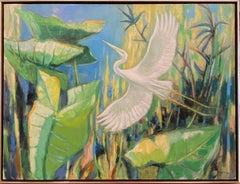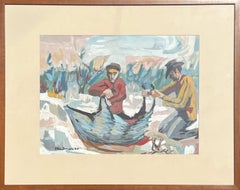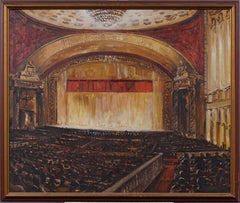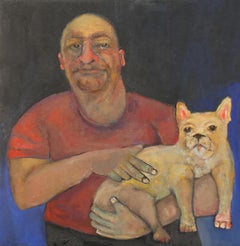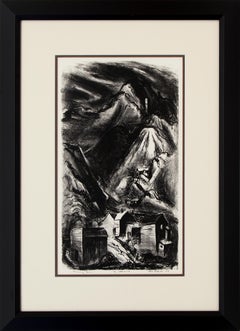Otis Dozier Art
American, 1904-1987
Born in Forney, Texas, Otis Marion Dozier was raised on a farm in Mesquite, Texas. Dozier was a muralist, potter, lithographer, sculptor, and painter. Dozier was a member of a group of Texas regionalist artists known as the "Dallas Nine." His surroundings in Texas became the focus of much of his art.
Dozier’s first artistic training took place in the early 1920’s when his family moved to Dallas. He studied under Vivian Aunspaugh, Cora Edge, and Frank Reaugh. His early subject matter was often the plight of farmers affected by the Great Depression.
In the 1930’s, Dozier became a member of the Dallas Artists League, and he taught at the Dallas School of Creative Arts. He was commissioned to paint murals at Texas A&M University and at Texas post offices in Arlington, Giddings, and Fredricksburg. His works were displayed at various exhibitions, including the Museum of Modern Art in New York in 1933, the Texas Centennial Exposition in 1936, the Denver Art Museum in 1943, and Dallas Allied Arts exhibitions in 1932, 1935, 1937, and 1946.
In 1938, Dozier studied at the Colorado Springs Fine Arts Center. Dozier served as Boardman Robinson’s assistant at the Fine Arts Center in the 1940’s. The Rocky Mountains became the focus of much of Dozier’s art, as he made over 3,000 sketches of Colorado ghost towns and mountains. When he returned to Dallas, he taught drawing at Southern Methodist University from 1945-1948. From the mid 1940’s until 1970, he taught drawing and painting at the Dallas Museum of Fine Arts.
Exhibited: “Dallas Nine,” 1932; Texas State Fair Exhib., 1933; Dallas Allied Artists, 1932 (Kiest Purchase Prize), 1935, 1937 & 1946; Southwestern Art Assn., 1948 (prize); New Orleans Arts and Crafts, 1948 (prize); MoMA traveling exhib., 1933; Texas Centennial Expo, 1936; GGE, 1939; Denver Art Mus., 1943 (prize); AIC, 1944, 1946; WMAA, 1940, 1945; Carnegie Inst., 1946; Pasadena, CA, 1946; Dallas Allied Artists, 1946; solo shows, Witte Mem. Mus., 1948; Corcoran Gal, 1951, 1953; Dallas Mus. Fine Arts, 1956.
Works held: Univ. Nebraska; Dallas Mus. Fine Arts; Denver Art Mus.; Metrop. Mus. of Art; Wadsworth Atheneum; Newark Mus.; A. & M. College, Bryan; Witte Mus.; Mus. FA, Houston.
Further Reading: Pikes Peak Vision: The Broadmoor Art Academy, 1919-1945. The Colorado Springs Fine Arts Center: Colorado Springs, 1989.; The Illustrated Biographical Encyclopedia of Artists of the American West, Peggy and Harold Samuels, Doubleday & Company, Inc., Garden City, New York, 1976.; Who Was Who in American Art 1564-1975: 400 Years of Artists in America, Vol. I. Peter Hastings Falk, Georgia Kuchen and Veronica Roessler, eds.,Sound View Press, Madison, Connecticut, 1999. 3 Vols.
©David Cook Galleries, LLCto
1
1
Overall Width
to
Overall Height
to
2
1
1
2
2
2
1
1
1
1
1
2
1
1
1
2
7,738
4,946
2,504
1,373
2
1
2
Artist: Otis Dozier
"IN FLIGHT" OTIS DOZIER MODERN CRAIN IN FLIGHT TEXAS ARTIST
By Otis Dozier
Located in San Antonio, TX
Otis Dozier
(1904 - 1987)
Dallas Artist
Image Size: 30 x 40
Frame Size: 32 x 42
Medium: Oil
Dated 1980
"In Flight"
Biography
Otis Dozier (1904 - 1987)
Otis Marion Dozier is noted as a member of a group of Texas regionalist artists known as the "Dallas Nine". His style was characterized by brilliant colors and strong forms, often focusing on the plight of farmers affected by the Great Depression.
Dozier was born in Forney, Texas in 1904. Raised on a farm in Mesquite, Texas with three siblings, his surroundings provided the materials that allowed him to cultivate a love for nature and wildlife. He once said, "youve got to start from where you are and hope to get to the universal." His surroundings became a primary focus for subject matter in his art. Other areas providing inspiration for his works would include the Big Bend and Gulf Coast areas of Texas, the Four Corners area of New Mexico, Arizona, and Utah, and the bayous and swamps of Louisiana. His earliest art training was in Dallas from Vivian Aunspaugh, Cora Edge, and Frank Reaugh when his family moved there in the early 1920s.
Dozier became a member of the Dallas Artists League in the 1930s after becoming involved with a group of regionalist artists. He taught at the Dallas School of Creative Arts from 1936 to 1938, while at the same time studying the various works of European artists such as Picasso, Leger, and Matisse. His initial style included bright colors and dominant forms but later moved to the earthy tones of beige, green, brown, and gray. In 1940, Dozier married and together he and his wife contributed much to the Dallas cultural scene.
Dozier attended the Colorado Springs Fine Arts Center in 1938 on a scholarship, studying with Boardman Robinson. For the next seven years he served as Boardmans assistant. While in Colorado, the Rocky Mountains became a favorite painting ground where he completed more than 3000 sketches of ghost towns and mountains. Influenced by Robinson, he developed a more fluid style and became an expert in the lithographic medium. Upon returning to Dallas, Dozier taught life drawing at Southern Methodist University from 1945 to 1948. From 1948 until 1970 he taught drawing and painting at the Dallas Museum of Fine Arts. He participated in sole exhibitions in the early to mid 1940s, as well as other major exhibitions at the Whitney Museum of American Art and the Metropolitan Museum of Art in New York City.
Dozier completed murals at the Agricultural and Mechanical College of Texas (Texas A&M University) and at various post offices in Texas. He won many awards at various exhibitions, including the International Watercolor Exhibition in San Francisco in 1932; the Museum of Modern Art in New York in 1933; the First National Exhibition in New York in 1936; Allied Arts exhibitions in 1932, 1935, and 1947; and two Texas General exhibitions in 1946 and 1947. His works may be found in the permanent collections of the Museum of Fine Arts in Houston; the Archer M. Huntington Art Gallery at the University of Texas at Austin; the Modern Art Museum of Fort Worth; the Marion Koogler McNay Art Museum in San Antonio; the Dallas Museum of Art; and the Panhandle-Plains Museum in Canyon, among others.
Dozier died of heart failure in 1987.
Additional exhibition venues:
Otis Dozier: A Centennial Celebration 1904-1987
The McKinney Avenue Contemporary, November 6 - December 10, 2004
OTIS DOZIER (1904-1987)
Otis Dozier was born in Forney, Texas in 1904 and was raised on a farm in nearby Mesquite. Dozier enjoyed drawing and painting from an early age, and a visit to the Texas State Fair convinced him to pursue art as a vocation. Dozier recalled visiting the Fair’s rotunda and, there, seeing an early work by Mexican muralist Diego Rivera. Dozier did not understand the image but was fascinated by it, later recalling that looked like blood and buttermilk to him; he just looked and looked; the newspaper said it was so great and he was willing to learn but couldn’t understand why it was so great. Dozier’s family moved to Dallas at the beginning of the 1920s, and it was there that he would receive artistic training under Vivian Aunspaugh, Cora Edge, and Frank Reaugh. Dozier would study with Aunspaugh for two years. She introduced Dozier to art history and spoke highly of the Impressionists, although she was cooler towards the Cubists and Fauvists who represented France’s new vogue.
Dozier became a member of the Dallas Artists League in the 1930s. He taught at the Dallas School of Creative Arts from 1936 to 1938 and was a significant member of the burgeoning Dallas art scene. Otis Dozier was a member of the cadre of Dallas artists known as the “Dallas Nine.” Though the disparate group of painters, printmakers and sculptors who composed the Nine could be broadly categorized as regionalists, they often displayed a decided fascination with the European avant-garde. This is especially true of Otis Dozier’s works, in which regionalist subject matter was often mingled with Surrealist and Cubist techniques. Starting in 1936, Dozier—as well as the other members of the Dallas Nine—began exhibiting their work at local, regional and national exhibitions. In 1936, Dozier, along with 713 artists from 47 states, attended the First National Exhibition of American Art at Rockefeller Center in New York. Dozier himself participated in numerous solo exhibitions during the mid-1940s and contributed to exhibitions in New York’s Whitney Museum of American Art and Metropolitan Museum of Art.
In 1945, Dozier returned to Dallas. He had been invited by fellow artist Jerry Bywaters...
Category
1980s Modern Otis Dozier Art
Materials
Oil
Modern Early Texas Western Wilderness Landscape Scene of Two Men and a Hog
By Otis Dozier
Located in Houston, TX
Modern Western wilderness scene by early Texas artist Otis Dozier. The work features two men kneeling and cleaning a hog set against a desert landscape. Signed and dated in the front lower left corner. Currently hung in a wooden frame with a cream matting.
Visible Dimensions Without Frame: H 14 in. x W 19 in.
Artist Biography: Otis Dozier (1904-1987) was raised on a cotton farm between Forney and Mesquite, developing a love for art and nature at a young age. After his family moved into Dallas in 1920, he received his earliest art training from well-known instructor Vivian Aunspaugh. Following his 1925 graduation from Forest High School, Dozier continued his art studies at the Dallas Art Institute with Olin Travis and Tom Stell. Also, during the 1920s, he accompanied his parents and three sisters on at least three automobile trips through the American West, familiarizing himself with the region that he would later depict in his art.
Six of Dozier’s works were included in 1932’s “Exhibition of Young Dallas Painters”; a number of these artists, including Dozier, Jerry Bywaters, John Douglass...
Category
1940s American Modern Otis Dozier Art
Materials
Gouache
Related Items
Antique American Large Impressionist Opera Scene Framed Signed Oil Painting
Located in Buffalo, NY
Impressive early American impressionist theatre interior painting. Oil on canvas. Framed. Signed. Image size, 30 by 36 inches.
Category
1970s Modern Otis Dozier Art
Materials
Canvas, Oil
H 34 in W 40 in D 2 in
mr. c and gladys, bright colorful man and dog
By Stephen Basso
Located in Brooklyn, NY
*ABOUT Stephen Basso
Stephen Basso's highly original pastels and oil paintings are romantic, yet thought provoking fantasies. His whimsical works are alive with boundless imagina...
Category
2010s American Modern Otis Dozier Art
Materials
Canvas, Oil
Oil Painting of Cubist Boats
By Chester Dixon Snowden 1
Located in Houston, TX
Seascape view of a boat dock. Painting is in a cubist style with neutral tones. The artist uses color and shape to create depth in the painting. Placed in a thick wooden frame. Artis...
Category
1950s Modern Otis Dozier Art
Materials
Oil
1950s Old Airfield in Capitola, California Landscape Oil Painting with Trees
By Jon Blanchette
Located in Denver, CO
This vintage 1950s-1960s oil painting titled 'Old Airfield in Capitola, California' beautifully captures a serene Northern California landscape. The scene depicts a lush countryside with vibrant trees, a charming white house with a green roof, a red tractor...
Category
Mid-20th Century American Modern Otis Dozier Art
Materials
Oil
H 23 in W 27 in D 1.125 in
Seascape - Oil Paint by Michele Ricciuti - 1980s
Located in Roma, IT
Oil on table realize by Michele Ricciuti in 1980s.
Hand signed.
In good condition, includes a contemporary wooden frame.
Category
1980s Modern Otis Dozier Art
Materials
Oil
H 22.84 in W 26.78 in D 0.04 in
'Hungarian Landscape', Ukrainian Post-Impressionist, Budapest, Hungary, Israeli
Located in Santa Cruz, CA
Signed lower left, 'Unik' for Leonid Unik (Ukrainian-Hungarian, born 1951) and inscribed, verso, on stretcher bar, with signature and title, 'Hongre' (Hungary).
Leonid Unik first st...
Category
1970s Modern Otis Dozier Art
Materials
Canvas, Oil
H 18 in W 21.75 in D 0.5 in
Antique American Nocturnal Street Scene Nicely Framed Modernist Oil Painting
Located in Buffalo, NY
Very finely painted American modernist street scene painting. Oil on canvas board. In excellent original condition. Handsomely framed in a giltwood molding. Excellent condition, ...
Category
1940s Modern Otis Dozier Art
Materials
Canvas, Oil, Board
H 27 in W 23 in D 2 in
Vintage Mid-Century Modern Swedish Landscape Framed Oil Painting - Fauvist Field
Located in Bristol, GB
FAUVIST FIELD
Size: 43 x 73 cm (including frame)
Oil on board
A bright and vividly coloured mid century landscape composition, executed in oil onto board and dated 1963.
Characteri...
Category
1960s Modern Otis Dozier Art
Materials
Oil, Board
New Black & White: Abstract Expressionist Contemporary Landscape
By Peter Rossiter
Located in Brecon, Powys
New Black & White
Mixed Media on board, a monochrome interpretation of a mountain landscape.
Peter Rossiter was born in Cambridge, UK in 1950 and studied at York University & The Courtauld Institute, London. Peter's background is rooted in the global art world; his Grandfather was the German artist Martin Bloch...
Category
21st Century and Contemporary Modern Otis Dozier Art
Materials
Mixed Media, Oil
The Bug, Early 20th Century Landscape w/ Rooster & Chicken, Cleveland School
By Henry Keller
Located in Beachwood, OH
Henry George Keller (American, 1869-1949)
The Bug
Gouache on illustration board
Signed lower left
30 x 21 inches
39 x 31 inches, framed
Keller, a leading painter in Cleveland, was b...
Category
Early 20th Century Otis Dozier Art
Materials
Gouache
Villajoyosa, Spain by Alexandre de Spengler - Oil on Masonite 44x78 cm
By Alexandre De Spengler
Located in Geneva, CH
Alexandre de Spengler (1893–1973) was a Swiss painter and engraver active in Geneva and Paris.
He is known for his land and seascapes, as well as...
Category
1950s Modern Otis Dozier Art
Materials
Oil, Masonite
H 17.33 in W 30.71 in D 0.4 in
Jefferson Market Library (Courthouse)
Located in Los Angeles, CA
This painting is part of our exhibition America Coast to Coast: Artists of the 1930s
Jefferson Market Library (Courthouse), c. 1930s, oil on canvas, 30 x 24 inches, signed lower right; presented in a newer silver painted frame
About the Painting
Writing about an exhibition of Charles W. Adams’ work at the Eighth Street Art Gallery in the mid-1930s, Emily Grenauer observed in The World-Telegram that the artist’s paintings were “distinguished for their solid form, well organized design and sumptuous color” and the art critic for The Herald Tribune found Adam’s work “a strong, formal realization of his subject . . . he paints with vital emphasis on structure and composition.” Although we do not know which works these critics referenced, it is likely they were writing about paintings like Jefferson Market Library (Courthouse). With its carefully designed reality, strong angles, solid forms, and well-disciplined puffs of smoke in the background, Adams presents a highly structured version of the Greenwich Village landmark, the Jefferson Market Library, which was a courthouse at the time Adams completed this work. The Jefferson Market Library was a prized subject for downtown painters, including the Ashcan School painter, John Sloan, the modernist, Stuart Davis, and the precisionist, Francis Criss...
Category
1930s American Modern Otis Dozier Art
Materials
Oil
Previously Available Items
"ELEPHANT OF MYSORE" OTIS DOZIER MODERN DATE 1959 TEXAS ARTIST
By Otis Dozier
Located in San Antonio, TX
Otis Dozier
(1904 - 1987)
Dallas Artist
Image Size: 35 x 45
Frame Size: 43 x 53
Medium: Oil
Dated 1959
"Elephant of Mysore"
Biography
Otis Dozier (1904 - 1987)
Otis Marion Dozier is noted as a member of a group of Texas regionalist artists known as the "Dallas Nine". His style was characterized by brilliant colors and strong forms, often focusing on the plight of farmers affected by the Great Depression.
Dozier was born in Forney, Texas in 1904. Raised on a farm in Mesquite, Texas with three siblings, his surroundings provided the materials that allowed him to cultivate a love for nature and wildlife. He once said, "youve got to start from where you are and hope to get to the universal." His surroundings became a primary focus for subject matter in his art. Other areas providing inspiration for his works would include the Big Bend and Gulf Coast areas of Texas, the Four Corners area of New Mexico, Arizona, and Utah, and the bayous and swamps of Louisiana. His earliest art training was in Dallas from Vivian Aunspaugh, Cora Edge, and Frank Reaugh when his family moved there in the early 1920s.
Dozier became a member of the Dallas Artists League in the 1930s after becoming involved with a group of regionalist artists. He taught at the Dallas School of Creative Arts from 1936 to 1938, while at the same time studying the various works of European artists such as Picasso, Leger, and Matisse. His initial style included bright colors and dominant forms but later moved to the earthy tones of beige, green, brown, and gray. In 1940, Dozier married and together he and his wife contributed much to the Dallas cultural scene.
Dozier attended the Colorado Springs Fine Arts Center in 1938 on a scholarship, studying with Boardman Robinson. For the next seven years he served as Boardmans assistant. While in Colorado, the Rocky Mountains became a favorite painting ground where he completed more than 3000 sketches of ghost towns and mountains. Influenced by Robinson, he developed a more fluid style and became an expert in the lithographic medium. Upon returning to Dallas, Dozier taught life drawing at Southern Methodist University from 1945 to 1948. From 1948 until 1970 he taught drawing and painting at the Dallas Museum of Fine Arts. He participated in sole exhibitions in the early to mid 1940s, as well as other major exhibitions at the Whitney Museum of American Art and the Metropolitan Museum of Art in New York City.
Dozier completed murals at the Agricultural and Mechanical College of Texas (Texas A&M University) and at various post offices in Texas. He won many awards at various exhibitions, including the International Watercolor Exhibition in San Francisco in 1932; the Museum of Modern Art in New York in 1933; the First National Exhibition in New York in 1936; Allied Arts exhibitions in 1932, 1935, and 1947; and two Texas General exhibitions in 1946 and 1947. His works may be found in the permanent collections of the Museum of Fine Arts in Houston; the Archer M. Huntington Art Gallery at the University of Texas at Austin; the Modern Art Museum of Fort Worth; the Marion Koogler McNay Art Museum in San Antonio; the Dallas Museum of Art; and the Panhandle-Plains Museum in Canyon, among others.
Dozier died of heart failure in 1987.
Additional exhibition venues:
Otis Dozier: A Centennial Celebration 1904-1987
The McKinney Avenue Contemporary, November 6 - December 10, 2004
OTIS DOZIER (1904-1987)
Otis Dozier was born in Forney, Texas in 1904 and was raised on a farm in nearby Mesquite. Dozier enjoyed drawing and painting from an early age, and a visit to the Texas State Fair convinced him to pursue art as a vocation. Dozier recalled visiting the Fair’s rotunda and, there, seeing an early work by Mexican muralist Diego Rivera. Dozier did not understand the image but was fascinated by it, later recalling that looked like blood and buttermilk to him; he just looked and looked; the newspaper said it was so great and he was willing to learn but couldn’t understand why it was so great. Dozier’s family moved to Dallas at the beginning of the 1920s, and it was there that he would receive artistic training under Vivian Aunspaugh, Cora Edge, and Frank Reaugh. Dozier would study with Aunspaugh for two years. She introduced Dozier to art history and spoke highly of the Impressionists, although she was cooler towards the Cubists and Fauvists who represented France’s new vogue.
Dozier became a member of the Dallas Artists League in the 1930s. He taught at the Dallas School of Creative Arts from 1936 to 1938 and was a significant member of the burgeoning Dallas art scene. Otis Dozier was a member of the cadre of Dallas artists known as the “Dallas Nine.” Though the disparate group of painters, printmakers and sculptors who composed the Nine could be broadly categorized as regionalists, they often displayed a decided fascination with the European avant-garde. This is especially true of Otis Dozier’s works, in which regionalist subject matter was often mingled with Surrealist and Cubist techniques. Starting in 1936, Dozier—as well as the other members of the Dallas Nine—began exhibiting their work at local, regional and national exhibitions. In 1936, Dozier, along with 713 artists from 47 states, attended the First National Exhibition of American Art at Rockefeller Center in New York. Dozier himself participated in numerous solo exhibitions during the mid-1940s and contributed to exhibitions in New York’s Whitney Museum of American Art and Metropolitan Museum of Art.
In 1945, Dozier returned to Dallas. He had been invited by fellow artist Jerry Bywaters...
Category
1950s Modern Otis Dozier Art
Materials
Oil
H 43 in W 50 in D 3 in
1940s Vertical American Modern Mining Town Landscape Lithograph, Mountain Scene
By Otis Dozier
Located in Denver, CO
Lithograph titled "Mining Town" by Otis Dozier (1904-1987) from 1940. Modernist scene of a mountain mining town with several buildings at the base of the mountain. Presented in a custom black frame, outer dimensions measure 25 ½ x 18 ⅜ x ¼ inches. Image sight size is 16 ¼ x 9 ½ inches.
Print is clean and in very good condition - please contact us for a detailed condition report.
Provenance: Private Collection, Denver, Colorado
Expedited and international shipping is available - please contact us for a quote.
About the Artist:
Born in Forney, Texas, Otis Marion Dozier was raised on a farm in Mesquite, Texas. Dozier was a muralist, potter, lithographer, sculptor, and painter. Dozier was a member of a group of Texas regionalist artists known as the "Dallas Nine." His surroundings in Texas became the focus of much of his art.
Dozier’s first artistic training took place in the early 1920’s when his family moved to Dallas. He studied under Vivian Aunspaugh, Cora Edge, and Frank Reaugh...
Category
1940s Abstract Otis Dozier Art
Materials
Paper, Lithograph
H 25.5 in W 18.5 in D 0.25 in
"MESAS" TEXAS MODERNIST OTIS DOZIER 1957 MCM MID CENTURY MODERN
By Otis Dozier
Located in San Antonio, TX
Otis Dozier
(1904 - 1987)
Dallas Artist
Image Size: 24 x48
Frame Size: 26 x 50
Medium: Oil on Masonite
Dated 1957
"Mesas"
Unsigned from his estate with letter from executor. Plus es...
Category
1950s Modern Otis Dozier Art
Materials
Oil
H 26 in W 50 in D 3 in
"YELLOW MOUNTAIN COUNTRY" WEST TEXAS
By Otis Dozier
Located in San Antonio, TX
Otis Dozier
(1904 - 1987)
Dallas Artist
Image Size: 23.5 x 29.5
Frame Size: 25 x 31
Medium: Oil
"Yellow Mountain Country"
Biography
Otis Dozier (1904 - 1987)
Otis Marion Dozier is no...
Category
1970s Modern Otis Dozier Art
Materials
Oil
"MESA" Mid Century New Mexico
By Otis Dozier
Located in San Antonio, TX
Otis Dozier (1904 - 1987) Dallas Artist Image Size: 6 x 10.5 Frame Size: 22 x 17.5 m Medium: Watercolor 1957 "Mesa"
Category
1950s Modern Otis Dozier Art
Materials
Watercolor
Rooster with Thistles
By Otis Dozier
Located in Dallas, TX
This is a Printer's Proof. The price does not include a frame.
The following essay by Kendall Curlee is from the Handbook of Texas Online; scroll down for complete citation.
Otis Dozier, painter, printmaker, and teacher who first became prominent as a member of the Dallas Nine, a group of regionalist artists, was born on March 27, 1904, in Forney, Texas, one of four children of James M. and Valta (Farmer) Dozier. He was raised on a farm in nearby Mesquite and developed a love for wildlife and nature, which later became the primary subject matter of his art. In the early 1920's his family moved to Dallas, where Dozier received his earliest art training from Vivian Aunspaugh, Frank Reaugh, and Cora Edge.
During the 1930's Dozier became involved with the circle of regionalist artists then active in Dallas. He was a charter member of the Dallas Artists League, exhibited his work in the Dallas Allied Arts exhibitions, and from 1936 to 1938 taught at the Dallas School of Creative Arts. During this period, while studying works by Matisse, Picasso, Léger, Derain, and other European artists reproduced in back issues of Dial, Dozier developed a style characterized by strong forms and brilliant colors. By the mid-1930's he had tightened up his brushwork and muted his palette to the earthy grays, beiges, greens, and browns favored by regionalist artists. Several of his major works from this era focused on the plight of farmers dispossessed by the Great Depression. In Annual Move (1936), for example, a family loads up the car with cherished possessions, ready to move on through the barren brown landscape; in Grasshopper and Farmer (1937), a baleful, outsized grasshopper pins...
Category
Late 20th Century American Modern Otis Dozier Art
Materials
Paper, Lithograph
Crows
By Otis Dozier
Located in Dallas, TX
Color lithograph with collage on paper
Color Trial Proof
Signed "Otis Dozier '87" at lower right
Category
1980s Modern Otis Dozier Art
Materials
Lithograph, Paper
Place in the Desert
By Otis Dozier
Located in Dallas, TX
signed "Otis Dozier '47" at lower right and dated "March 3, 1947" on verso
Category
1940s Modern Otis Dozier Art
Materials
Panel, Oil
Rooster with Thistles
By Otis Dozier
Located in Dallas, TX
Edition 4/10
The following essay by Kendall Curlee is from the Handbook of Texas Online; scroll down for complete citation.
Otis Dozier, painter, printmaker, and teacher who first became prominent as a member of the Dallas Nine, a group of regionalist artists, was born on March 27, 1904, in Forney, Texas, one of four children of James M. and Valta (Farmer) Dozier. He was raised on a farm in nearby Mesquite and developed a love for wildlife and nature, which later became the primary subject matter of his art. In the early 1920s his family moved to Dallas, where Dozier received his earliest art training from Vivian Aunspaugh, Frank Reaugh, and Cora Edge.
During the 1930s Dozier became involved with the circle of regionalist artists then active in Dallas. He was a charter member of the Dallas Artists League, exhibited his work in the Dallas Allied Arts exhibitions, and from 1936 to 1938 taught at the Dallas School of Creative Arts. During this period, while studying works by Matisse, Picasso, Léger, Derain, and other European artists reproduced in back issues of Dial, Dozier developed a style characterized by strong forms and brilliant colors. By the mid-1930s he had tightened up his brushwork and muted his palette to the earthy grays, beiges, greens, and browns favored by regionalist artists. Several of his major works from this era focused on the plight of farmers dispossessed by the Great Depression. In Annual Move (1936), for example, a family loads up the car with cherished possessions, ready to move on through the barren brown landscape; in Grasshopper and Farmer (1937), a baleful, outsized grasshopper pins...
Category
1980s Otis Dozier Art
Materials
Lithograph
Grasshopper
By Otis Dozier
Located in Dallas, TX
edition 13/30
paper size is 19 3/4 x 26 inches
The following essay by Kendall Curlee is from the Handbook of Texas Online; scroll down for complete citation.
Otis Dozier, painter, printmaker, and teacher who first became prominent as a member of the Dallas Nine, a group of regionalist artists, was born on March 27, 1904, in Forney, Texas, one of four children of James M. and Valta (Farmer) Dozier. He was raised on a farm in nearby Mesquite and developed a love for wildlife and nature, which later became the primary subject matter of his art. In the early 1920s his family moved to Dallas, where Dozier received his earliest art training from Vivian Aunspaugh, Frank Reaugh,qqv and Cora Edge.
During the 1930s Dozier became involved with the circle of regionalist artists then active in Dallas. He was a charter member of the Dallas Artists League, exhibited his work in the Dallas Allied Arts exhibitions, and from 1936 to 1938 taught at the Dallas School of Creative Arts. During this period, while studying works by Matisse, Picasso, Léger, Derain, and other European artists reproduced in back issues of Dial, Dozier developed a style characterized by strong forms and brilliant colors. By the mid-1930s he had tightened up his brushwork and muted his palette to the earthy grays, beiges, greens, and browns favored by regionalist artists. Several of his major works from this era focused on the plight of farmers dispossessed by the Great Depression. In Annual Move (1936), for example, a family loads up the car with cherished possessions, ready to move on through the barren brown landscape; in Grasshopper and Farmer (1937), a baleful, outsized grasshopper pins...
Category
1980s Modern Otis Dozier Art
Materials
Lithograph
Otis Dozier art for sale on 1stDibs.
Find a wide variety of authentic Otis Dozier art available for sale on 1stDibs. You can also browse by medium to find art by Otis Dozier in paint, oil paint, gouache and more. Much of the original work by this artist or collective was created during the 20th century and is mostly associated with the modern style. Not every interior allows for large Otis Dozier art, so small editions measuring 19 inches across are available. Customers who are interested in this artist might also find the work of Cecil Crosley Bell, Paul Sample, and William Clutz. Otis Dozier art prices can differ depending upon medium, time period and other attributes. On 1stDibs, the price for these items starts at $1,200 and tops out at $25,000, while the average work can sell for $18,750.
